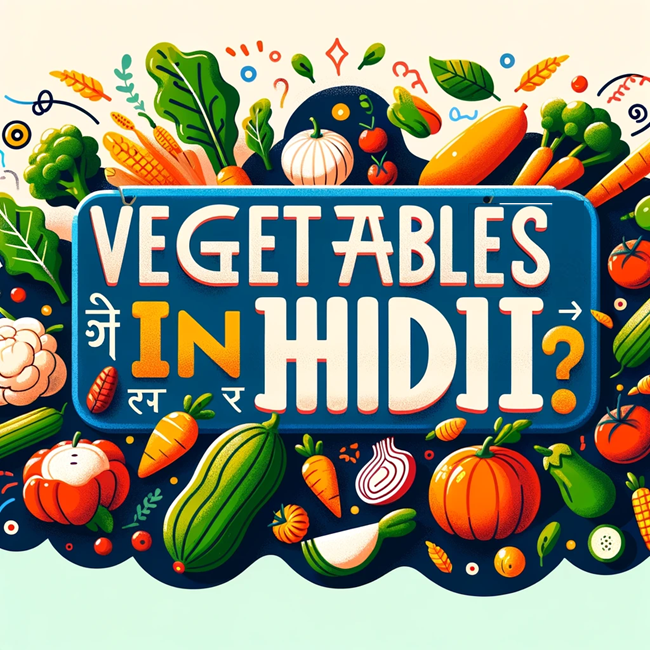Vegetables Name in Hindi: A Comprehensive Guide to Understanding and Learning

Welcome to our detailed guide on “Vegetables Name in Hindi.” Whether you’re a language enthusiast, a student, or someone interested in enhancing their Hindi vocabulary, this article is tailored for you. We’ll explore a wide range of vegetables, providing their names in both Hindi and English. This guide aims to be a helpful resource for those learning Hindi or English, and for anyone interested in the diverse world of vegetables.
Also Read:- What Are The 5 Layers Of Soil
The Importance of Knowing Vegetable Names in Multiple Languages
Understanding the names of vegetables in different languages, especially in Hindi and English, is not just about expanding your linguistic skills. It’s also about embracing cultural diversity, improving communication in a multilingual world, and enhancing your knowledge in the field of culinary arts and nutrition.
Vegetables Name in Hindi and English: A-Z List
Let’s dive into our comprehensive list of vegetables, presenting over 100 vegetables name in Hindi and English.
- Potato – आलू (Aloo)
- Tomato – टमाटर (Tamatar)
- Onion – प्याज (Pyaaz)
- Carrot – गाजर (Gajar)
- Cabbage – पत्ता गोभी (Patta Gobhi)
- Cauliflower – फूल गोभी (Phool Gobhi)
- Spinach – पालक (Palak)
- Eggplant/Brinjal – बैंगन (Baingan)
- Green Peas – मटर (Matar)
- Bell Pepper – शिमला मिर्च (Shimla Mirch)
- Cucumber – खीरा (Kheera)
- Beetroot – चुकंदर (Chukandar)
- Radish – मूली (Mooli)
- Pumpkin – कद्दू (Kaddu)
- Bitter Gourd – करेला (Karela)
- Bottle Gourd – लौकी (Lauki)
- Lady Finger/Okra – भिंडी (Bhindi)
- Mushroom – मशरूम (Mashroom)
- Ginger – अदरक (Adrak)
- Garlic – लहसुन (Lahsun)
- Broccoli – ब्रोकोली (Broccoli)
- Lettuce – सलाद पत्ता (Salad Patta)
- Sweet Potato – शकरकंद (Shakarkand)
- Turnip – शलजम (Shaljam)
- Corn – मक्का (Makka)
- Asparagus – शतावरी (Shatavari)
- Zucchini – ज़ुकीनी (Zucchini)
- Leek – लीक (Leek)
- Celery – अजवाइन की पत्तियाँ (Ajwain ki Pattiyaa)
- Artichoke – हाथी चक (Hathi Chak)
- Fenugreek Leaves – मेथी के पत्ते (Methi ke Patte)
- Spring Onion – हरा प्याज (Hara Pyaaz)
- Chili – मिर्च (Mirch)
- Bamboo Shoot – बांस की कोंपल (Bans ki Komal)
- Squash – स्क्वैश (Squash)
- Drumstick – सहजन (Sahjan)
- Colocasia – अरबी (Arbi)
- Yam – जिमीकंद (Jimikand)
- Green Beans – हरी बीन्स (Hari Beans)
- Snow Peas – स्नो पीज़ (Snow Peas)
- Ridge Gourd – तुरई (Turai)
- Ivy Gourd – कुंदरू (Kundru)
- Brussels Sprouts – ब्रसेल्स अंकुरित (Brussels Ankurit)
- Parsnip – पार्सनिप (Parsnip)
- Swiss Chard – स्विस चार्ड (Swiss Chard)
- Kale – केल (Kale)
- Mustard Greens – सरसों का साग (Sarson ka Saag)
- Endive – एंडाइव (Endive)
- Romaine Lettuce – रोमेन लेट्यूस (Romen Lettuce)
- Watercress – जलकुंभी (Jalkumbhi)
- Arugula – अरुगुला (Arugula)
- Fiddlehead – फिडलहेड (Fiddlehead)
- Dandelion Greens – डैंडेलियन ग्रीन्स (Dandelion Greens)
- Chard – चार्ड (Chard)
- Collard Greens – कोलार्ड ग्रीन्स (Collard Greens)
- Rutabaga – रुटाबागा (Rutabaga)
- Jicama – जिकामा (Jicama)
- Kohlrabi – कोहलराबी (Kohlrabi)
- Horseradish – हॉर्सरेडिश (Horseradish)
- Jerusalem Artichoke – जेरूसलम आर्टिचोक (Jerusalem Artichoke)
- Daikon – दाइकोन (Daikon)
- Taro – अरबी (Arbi)
- Bok Choy – बोक चॉय (Bok Choy)
- Napa Cabbage – नापा कैबेज (Napa Cabbage)
- Seaweed – समुद्री शैवाल (Samudri Shaival)
- Chayote – चायोटे (Chayote)
- Okra – भिंडी (Bhindi)
- Fava Beans – फावा बीन्स (Fava Beans)
- Lima Beans – लीमा बीन्स (Lima Beans)
- Winged Bean – विंग्ड बीन (Winged Bean)
- Pinto Bean – पिंटो बीन (Pinto Bean)
- Navy Bean – नेवी बीन (Navy Bean)
- Black Bean – ब्लैक बीन (Black Bean)
- Kidney Bean – किडनी बीन (Kidney Bean)
- Soybean – सोयाबीन (Soyabean)
- Chickpeas – चना (Chana)
- Lentil – मसूर (Masoor)
- Pea – मटर (Matar)
- Black-eyed Pea – लोबिया (Lobiya)
- Adzuki Bean – अड्जुकी बीन (Adzuki Bean)
- Mung Bean – मूंग (Moong)
- Scarlet Runner Bean – स्कारलेट रनर बीन (Scarlet Runner Bean)
- Broad Bean – ब्रॉड बीन (Broad Bean)
- Green Bean – हरी बीन (Hari Bean)
- Snap Pea – स्नैप मटर (Snap Matar)
- Cowpea – काउपी (Cowpea)
- Butter Bean – बटर बीन (Butter Bean)
- Cannellini Bean – कैनेलिनी बीन (Cannellini Bean)
- Flageolet Bean – फ्लेजोलेट बीन (Flageolet Bean)
- Great Northern Bean – ग्रेट नॉर्दर्न बीन (Great Northern Bean)
- Lupini Bean – लुपिनी बीन (Lupini Bean)
- Tepary Bean – टेपरी बीन (Tepary Bean)
- Cranberry Bean – क्रैनबेरी बीन (Cranberry Bean)
- Roman Bean – रोमन बीन (Roman Bean)
- Anasazi Bean – अनासाज़ी बीन (Anasazi Bean)
- Lima Bean – लीमा बीन (Lima Bean)
- Garbanzo Bean – गारबैंज़ो बीन (Garbanzo Bean)
- Black Turtle Bean – ब्लैक टर्टल बीन (Black Turtle Bean)
- Red Kidney Bean – रेड किडनी बीन (Red Kidney Bean)
- White Kidney Bean – व्हाइट किडनी बीन (White Kidney Bean)
Benefits of Learning Vegetable Names in Hindi and English
Learning the names of vegetables in both Hindi and English has several benefits:
- Enhanced Communication: It helps in communicating effectively in a multilingual environment, especially in countries like India where both languages are widely used.
- Culinary Knowledge: For those interested in cooking, knowing these names is essential for following recipes and exploring diverse cuisines.
- Educational Value: It’s particularly useful for students and educators in bilingual settings.
- Cultural Appreciation: Understanding the names in both languages fosters a deeper appreciation of the cultural diversity and culinary traditions associated with these vegetables.
Conclusion
We hope this extensive list of vegetables name in Hindi and English enhances your vocabulary and aids in your language learning journey. Remember, learning a new language opens doors to understanding different cultures and traditions. Happy learning!








